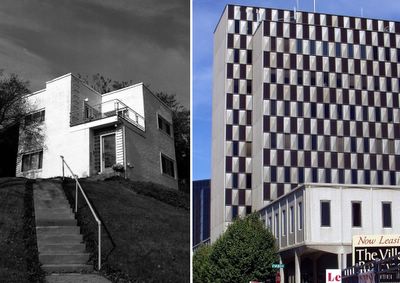
Harris Armstrong was St. Louis’ most famous modern architect. Some in-tact examples of his work include (above left) a residence in South St. Louis up behind the Donut Drive-In on Chippewa, and a commercial building (above right) on Brentwood, across from Brentwood Square. Some of his remuddled buildings include the U-Haul skyscraper at Kingshighway & Hwy 44, and the former Library Ltd./Borders building at Forsyth & Hanley in downtown Clayton. Should architect Andrew Raimist gets some free time, he will unleash a proper book on the work of Harris Armstrong, which would cover a prolific 4-decade career of residential and commerical Midwest Modernism.
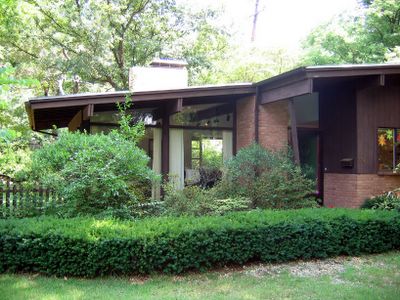
A Harris Armstrong-designed house from 1951 is for sale in Kirkwood. My lovely friend Marla had previously waved her Modern Magic Wand and gave me my first true taste of Lustron; now she graciously allowed me and an interior designer pal to get a peek inside an Armstrong.
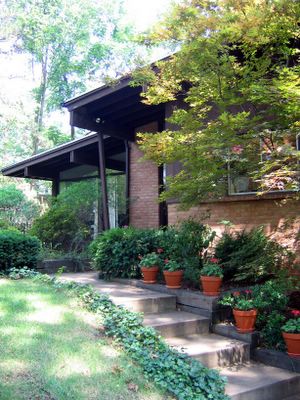
It’s the lead house of a cul-de-sac off Woodlawn Avenue, with 3 bedrooms, 1.5 baths, 2-car garage and an asking price of $249,000. From the front, its lines are very spare and the detail of the wood beams under the eave of the roof continuing uninterrupted through a large expanse of glass and into the living room is a nice touch.

The backside of the house severely lacks the subtle drama of the front, and that much brown becomes depressing. I refrained from scratching through some wood planks to find the original paint color, and while Armstrong favored natural colors for private residences, something tells me this brown was not it.
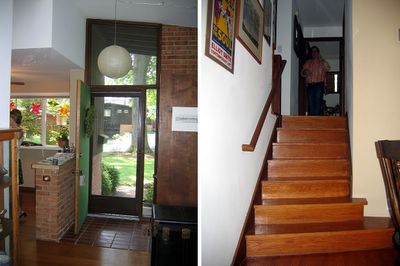
Inside, the entry foyer (above left) packs a bit of suburban ranch punch, though someone added a clumsy plywood guest closet at some point, breaking up the brick lines.
There’s plenty of light spilling into the living and dining room, and the stairs (above right) leading up to the bedroom level politely thrust at a jaunty little angle.
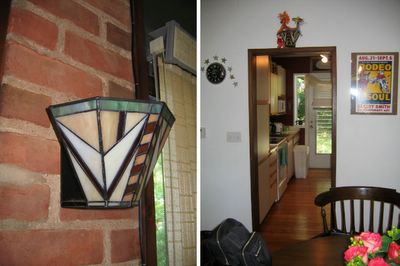
2 original light fixtures remain; one in the living room (above left) and the other above the entrance to the tiny, galley kitchen (above right).
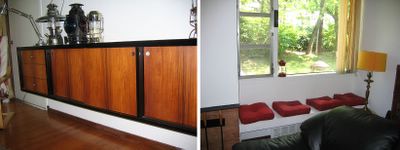
The only true Armstrongian touches are the handsome, floating cabinetry (above left) and a built-in window seat (above right) in the living room. After that, everything about the house was utterly normal and somewhat bland because of years of familiarity with this house type. Even though it’s a good size for a family of three, our current American standards of acceptable square footage makes the house seem small.
The designer pal summed it up best when he said the house looked like Armstrong had made a quick sketch of an idea and then handed it off to a builder. That most of the other houses in this cul-de-sac are slight variations on the theme (see next door neighbor, below), shows the builder ran with the idea, even improved upon it.
So, is the house really worth $249K?
Marla said $210K is about right for the immediate area, so the pedigree jacks up the price.
With a different exterior paint color (or two) and some extensive cleaning,* it would be a sharp, split-level ranch house that Harris Armstrong paid a bit of attention to.

* When a realtor suggests improvements, it’s not to pass judgement, but to make the house attractive to buyers, which makes it sell faster, which then benefits everyone involved. If the realtor should mention taking a quick swipe to yards of cobwebs on the exterior, man, you really should. It’s the least you could do if you want to sell the house for anywhere near the asking price.

I like this blog is fantastic, is really good written. Congratulation. Do you want to see something more? Read it…: Great investment opportunity in Costa Rica: houses for sale, homes for sale, investment property. Visit us for more info at: http://www.jaco-bay.com/
This is a good description of the house and an introduction to Armstrong’s work for people who are unfamiliar but interested.
I’ll add a few comments related to this house and its context.
Armstrong laid out and designed the entire subdivision in 1951. The neighborhood developer was a fellow named Marshall Berry. Over the course of several years, Armstrong collaborated with Berry on commercial developments, residential subdivisions, as well as designing Berry’s own home in Ladue.
The Woodleaf Court Subdivision consists of ten homes. There were three basic types designed by Armstrong. Its somewhat unclear to what extent Armstrong was involved in selecting the finishes and unique features of each house.
Clearly a great number of features in these homes are Armstrong motifs that were varied and repeated in many projects.
Armstrong collaborated with the same developer to create a subdivision in Creve Coeur called Sherwyn Lane.
The builder/construction company in each case was Kentland Construction Company. I don’t have much (if any real information on this builder).
All of the Woodleaf Court houses and many of the others Armstrong designed in the late 1940s through the 1950s were variations on a concept he’d developed years earlier for a home designed specifically for Missouri’s climate and culture.
The originary concept design was published in a book entitled “Your Solar House” by Libbey Owens Ford Glass Company (New York: Simon and Schuster, 1947). LOF was a major manufacturer of thermal pane glass and to promote its use throughout the country, they hired architects from each state in the country (49 at that time). Other architects selected for the publication included:
– Louis Kahn (PA)
– Edward Durrell Stone (NY)
– HughStubbins, Jr. (MA)
– George Fred Keck (IL)
– Alden B. Dow (MI)
– John Lloyd Wright (IN)
– Laurence Kocher (VA)
– Pietro Belluschi (OR)
– Harwell Hamilton Harris (CA)
– O’Neil Ford (TX)
Armstrong’s design for the “Missouri Solar Home” became the fundamental basis for virtually all of homes he designed and published in the following years.
Further information on Armstrong’s work and my research can be viewed on my websites (below).
Andrew Raimist
http://RaimistArchitecture.com
http://www.Flickr.com/Photos/Raimist
http://Remiss63.Blogspot.com/